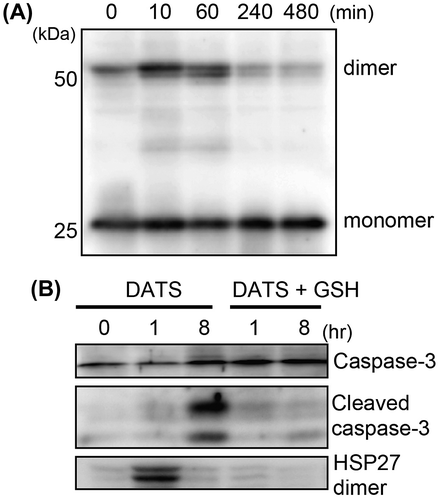Figures & data
Fig. 1. The effect of DATS on cell growth, cell cycle and activation of the proteins regulating apoptosis in U937.
Notes: U937 cells were seeded at a cellular density of 2 × 105 cells/mL and cultured for 24 h. Then the cells were incubated with various concentrations of DATS for 24 h. (A) The cell number was counted by hemocytometer and expressed as a percentage to the vehicle-treated control. (B) Cell cycle distribution analyzed by a flow cytometer. (C) Cleavage of caspase-3 and PARP detected by Western blotting.

Fig. 2. Redox 2D-PAGE analysis of U937 treated with DATS.
Notes: (A) Schematic outline of the redox 2D-PAGE. (B) Typical redox 2D-PAGE analysis of U937 treated with DATS. U937 cells were seeded at a cellular density of 2 × 105 cells/mL and cultured for 24 h. Then the cells were treated with 0.2% DMSO as vehicle control (Left panel) or with 10 μM DATS (Right panel) for 10 min and the cell lysates were subjected to the redox 2D-PAGE. The specific spot at approximately 27 kDa was identified to be HSP27.

Fig. 3. Formation of HSP27 dimer and cleaved caspase-3 in DATS-treated U937.
Notes: U937 cells were treated with 10 μM DATS for the times indicated in the panels. (A) HSP27 dimer formation was evaluated by non-reduced SDS-PAGE followed by Western blotting. (B) HSP27 dimer formation and the cleavage of caspase-3 were detected by Western blotting. U937 cells were also pretreated with GSH (1 mM) for 30 min prior to the DATS treatment (DATS + GSH).

